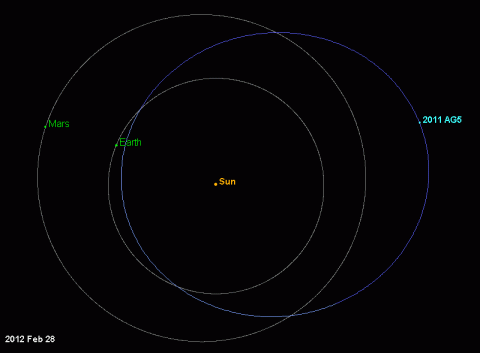Written by DC Agle
NASA’s Jet Propulsion Laboratory
 Pasadena, CA – Asteroid 2011 AG5 has been receiving a lot of attention lately because of a very unlikely scenario which would place it on an Earth-interception course 28 years from now. Here is a scientific reality check of this relatively nondescript space rock which is currently ranked a “1” on the 1 to 10 Torino Impact Hazard Scale
Pasadena, CA – Asteroid 2011 AG5 has been receiving a lot of attention lately because of a very unlikely scenario which would place it on an Earth-interception course 28 years from now. Here is a scientific reality check of this relatively nondescript space rock which is currently ranked a “1” on the 1 to 10 Torino Impact Hazard Scale
As of February 26th, 2012, asteroid 2011 AG5 is one of 8,744 near-Earth objects that have been discovered. It is approximately 460 feet (140 meters) in size and its orbit carries it as far out as beyond Mars’ orbit and as close to the sun as halfway between Earth and Venus. It was discovered on January 8th, 2011, by astronomers using a 60-inch Cassegrain reflector telescope located at the summit of Mount Lemmon in the Catalina Mountains north of Tucson, Arizona.

“In September 2013, we have the opportunity to make additional observations of 2011 AG5 when it comes within 91 million miles (147 million kilometers) of Earth,” said Don Yeomans, manager of NASA’s Near-Earth Object Program Office at the Jet Propulsion Laboratory in Pasadena, CA. “It will be an opportunity to observe this space rock and further refine its orbit. Because of the extreme rarity of an impact by a near-Earth asteroid of this size, I fully expect we will be able to significantly reduce or rule out entirely any impact probability for the foreseeable future.” Even better observations will be possible in late 2015.
2011 AG5 will next be near Earth in February of 2023 when it will pass the planet no closer than about 1.2 million miles (1.9 million kilometers). In 2028, the asteroid will again be in the area, coming no closer than about 12.8 million miles (20.6 million kilometers). The Near-Earth Object Program Office states the Earth’s gravitational influence on the space rock during these flybys has the potential to place the space rock on an impact course for February 5th, 2040, but this has very unlikely odds of occurring at 1-in-625.
NASA detects, tracks and characterizes asteroids and comets passing close to Earth using both ground- and space-based telescopes. The Near-Earth Object Observations Program, commonly called “Spaceguard,” discovers these objects, characterizes a subset of them, and determines their orbits to determine if any could be potentially hazardous to our planet.
JPL manages the Near-Earth Object Program Office for NASA’s Science Mission Directorate in Washington. JPL is a division of the California Institute of Technology in Pasadena.
More information about asteroids and near-Earth objects is at: http://www.jpl.nasa.gov/asteroidwatch .


